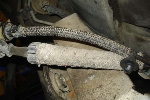This actually happens to a lot of new cars.
The smell is caused by the catalytic converter, but it is NOT broken. In fact, the bad smell is a sign that the converter is working quite well. It doesn't need to be fixed, and the smell will go away with time.
"So what is that awful smell? It's hydrogen sulfide or H2S. It does not exist in the fuel or oil, which is why you can't smell it at the gas station. It does, however, come from the gasoline. Almost all gasoline contains organic sulfur compounds with sulfur levels ranging from 30 to 100 parts per million, approximately.
"As the fuel burns, the organic sulfur compounds break down into simpler compounds. If the engine is running lean (more air than is needed to burn the fuel), the sulfur is likely to be SO2, or sulfur dioxide. The catalytic converter can change this into SO3 (sulfur trioxide), which then reacts with the catalyst to form sulfates on the catalyst. Over several minutes there is a build up of sulfates. If the engine suddenly starts to run rich (not enough air to burn all the fuel), such as when you stop at a red light, climb a steep hill, or brake hard to slow down, the chemistry changes. Now the sulfates are unstable and they react to form hydrogen sulfide, which is expelled from the exhaust pipe all at once. The high concentration is the reason for the bad smell! This effect is a common problem with new vehicles because the catalyst is working at a very high efficiency. However, as the catalyst gets older, the activity drops. Fortunately for us, one of the first reactions to be affected is the formation of hydrogen sulfide. So as the catalyst gets older, the smell will go away. It should also be noted that many catalysts never smell bad. One reason might be because the vehicle doesn't run lean for much of the time, or perhaps the catalyst has an extra component that reduces the production of hydrogen sulfide.
Thanks to, Dr. Gordon Bartley, a principal scientist in the Emissions Research Department of the Automotive Products and Emissions Research Division. Bartley specializes in the development, aging, and evaluation of vehicle emission catalysts.
Here is what H2S does to you, in case you didn't know.
What about longer term health effects? Some people who breathed in levels of hydrogen sulfide high enough to become unconscious continue to have headaches and poor attention span, memory, and motor function after waking up. Problems with the cardiovascular system have also been reported at exposures above permissible exposure limits. People who have asthma may be more sensitive to hydrogen sulfide exposure. That is, they may have difficulty breathing at levels lower than people without asthma.
The explosive range of hydrogen sulfide in air is 4.5 to 45.5 percent. This range is much higher than the PEL.
Safety Hazards
Hydrogen sulfide is a highly flammable, explosive gas, and can cause possible life-threatening situations if not properly handled. In addition, hydrogen sulfide gas burns and produces other toxic vapors and gases, such as sulfur dioxide.
In addition to exposure to hydrogen sulfide in the air, exposure to liquid hydrogen sulfide can cause "blue skin" or frostbite. If clothing becomes wet, avoid ignition sources, remove the clothing and isolate it in a safe area to allow it to evaporate.
The effect called knockdown (rapid unconsciousness) often results in falls that can seriously injure the worker.
The following resources provide more information on the safety and health effects of hydrogen sulfide:
Hydrogen Sulfide (H2S) (PDF*). OSHA Fact Sheet. (2005, October). Provides a concise list of industrial sources, symptoms and health effects of exposure to hydrogen sulfide, and OSHA requirements for the protection of workers.
Hydrogen Sulfide (H2S) (PDF). OSHA QuickCard. Provides the important safety precautions for hydrogen sulfide.
Workplace Safety and Health Topics - Hydrogen Sulfide. National Institute for Occupational Safety and Health (NIOSH). Provides a listing of NIOSH and related resources on hydrogen sulfide.
NIOSH Pocket Guide to Chemical Hazards. National Institute for Occupational Safety and Health (NIOSH) Publication No. 2005-149. Provides physical descriptions, exposure limits, measurement methods, personal protection and sanitation, first aid, respirator recommendations, exposure routes, symptoms, target organs, and other information about hydrogen sulfide.
IDLH Documentation for Hydrogen Sulfide. National Institute for Occupational Safety and Health (NIOSH), (Revised 1996, August 16). Describes how NIOSH determined hydrogen sulfide Immediately Dangerous to Life and Health (IDLH).
ToxFAQs for Hydrogen Sulfide. Agency for Toxic Substances and Disease Registry (ATSDR), (2006, July). Answers the most frequently asked health questions about hydrogen sulfide.
Toxicological Profile for Hydrogen Sulfide. Agency for Toxic Substances and Disease Registry (ATSDR), (2006, July). More detailed technical information on hydrogen sulfide, health effects, chemical and physical properties, potential for human exposure, and analytical methods.
Medical Management Guidelines for Hydrogen Sulfide. Agency for Toxic Substances and Disease Registry (ATSDR), (2006, April). Provides general information about hydrogen sulfide, its health effects, and specific medical treatments for hydrogen sulfide exposure.











